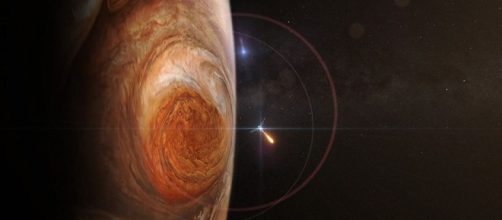Juno spacecraft has been flying around Jupiter every 53 days since July 4th, 2016 and today marks its first anniversary there. On its next approach to Jupiter, Juno is planned to fly directly over the Great Red Spot. This will allow it to take pictures and gather some science information about this gigantic feature on the gas giant planet. The encounter will take place on Monday 10 and all of Juno´s science instruments will be on to gather as much information about this gigantic storm.
The Great Red Spot
This is a permanent zone of high pressure causing an anticyclonic storm in Jupiter´s atmosphere.
Is located south of Jupiter´s equator and it´s approximately 16,000 km (10,000 miles) wide. This gigantic storm, along with the planet's bands, is visible even from earth with a commercial telescope. This feature on Jupiter´s atmosphere has existed for around 3 and one-half centuries and possibly more. It rotates counter-clockwise with a rotating period of six days. This storm is so huge that it could contain three planets the size of the earth.
Juno and the Red Spot
It´s planned that all of Juno´s science instruments be on during the approach to the Great Red Spot, during which it will take pictures with the JunoCam and study the real reaches of this storm into Jupiter’s interior. At the time of perijove, Juno will have reached a flying position above Jupiter’s cloud tops of about 3,500 km (2,200 miles); minutes later, it will be directly above the swirling clouds of the Great Red Spot.
At this precise time, Juno´s science instruments will all be switched on so that it can obtain all of the related scientific data.
Juno´s mission
Each time Juno is at perijove, it flies very low over Jupiter´s cloud tops, some 3,400 km (2,100 miles), each time studying Jupiter´s physical features, including its radiation belt, atmosphere temperature and composition, auroras and magnetic field. Juno´s main objective is to help scientists understand the origin and evolution of this planet. It´s thought that under Jupiter´s dense clouds are the secret that gave birth to the solar system and other planetary systems in the universe. Another important data to discover about Jupiter is its core composition, either solid of gaseous, which is important to the understanding of these types of planets.
Today- July 4 marks the first year since Juno was locked in an orbit around Jupiter. It will still flyby around Jupiter for another month until it ends its mission in February 2018.


